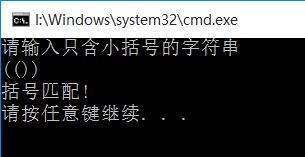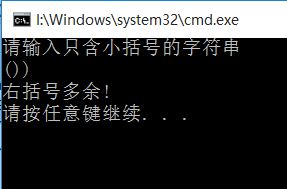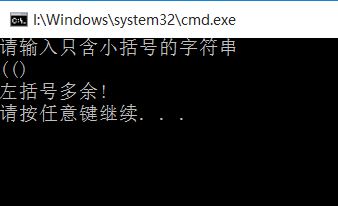更多內容請訪問我的個人官方網站www.huqi.tech
阿新 • • 發佈:2018-12-26
括號匹配演算法在各種程式設計的IDE工具中都會用到,用來檢測關於括號匹配的語法錯誤,括號匹配實際上不復雜,主要就是利用棧這個資料結構,掃描輸入的字串,若遇到左括號則直接入棧,若遇到右括號則彈出棧頂括號,看是否與當前括號型別相同(如同為小括號(),或同為[],注意括號應該是在英文輸入法的情況下輸入的),若相同則二者匹配,否則不匹配,另外,如果掃描完成,而棧中仍存在未匹配的括號,則說明不匹配,當且僅當掃描序列與棧中元素同時為空時才表示完全匹配。本部落格將詳細講解括號匹配演算法,為了將焦點聚焦在演算法本身上,僅僅只對小括號進行檢測是否匹配。
注:關於棧的另外一個典型應用就是表示式求值演算法,類似於計算器效果,具體可以參看我的部落格: 算術表示式
程式執行結果如下:# include<stdio.h> # include<string.h> # include<stdlib.h> typedef struct node { char a; struct node *pnext; }node,*linklist; void inistack(linklist s) { (s)->pnext=NULL; } void push(linklist top,char c) { linklist ptemp=(linklist)malloc(sizeof(node)); (ptemp)->a=c; ptemp->pnext=(top)->pnext; (top)->pnext=ptemp; } void pop(linklist top,char* c) { linklist ptemp; ptemp=(top)->pnext; *c=(ptemp)->a; if(ptemp==NULL) printf("棧空!"); (top)->pnext=ptemp->pnext; free(ptemp); } void get(linklist top,char *x) { *x=top->pnext->a; } int isempty(linklist s) { if(s->pnext==NULL) return 1; else return 0; } int match(char x,char y) { if((x=='(')&&(y==')')) return 1; else return 0; } void Match(char x[]) { node s; int i; char ch; inistack(&s); for(i=0;x[i]!='\0';i++) { if(x[i]=='(') { push(&s,x[i]); } else if(isempty(&s)) { printf("右括號多餘!\n"); return; } else { get(&s,&ch); if(match(ch,x[i])) { pop(&s,&ch); } else { printf("對應的括號不匹配!\n"); return; } } } if(isempty(&s)) printf("括號匹配!\n"); else printf("左括號多餘!\n"); } void main() { int i; char x[20]; printf("請輸入只含小括號的字串\n"); scanf("%s",x); Match(x); }




